

 Home page
Article created: Thursday, June 15, 2006
Home page
Article created: Thursday, June 15, 2006
|
Text Resize buttons |
Swiss Crest Application TheoryIt has been determined by detailed measurements of the "hand-stamped"* preproduction prototype Swiss crest that the dot, previously identified by a noted Luger author and advanced collector as the "fiducial" alignment point placed specifically for the application of the "radially" hand-stamped individual rays, is in fact an alignment dot applied to the chamber at the beginning of the process simply to establish the geometric center of the chamber for the application of the crest. Although the length of the chamber from the chamber face to the receiver/barrel interface is 21 mm, the dot is located equidistant from the forward top edge of the chamber extractor cut to the receiver/barrel interface, a length of 19.55 mm. This gives the appearance of the crest being centrally located, front to rear and right to left on the chamber.

This is a compelling argument since only four of the most likely first applied of the eighty individually stamped rays, when extended, perfectly intersect with the "fiducial" dot. These being the rays at 90°, 180°, 270° and 360°, which is in all probability a product of coincidence of geometry more than by design. The rays are grouped in eight 45° segments alternating between 9 and 11 rays per group. Theses groups align with eight different intersecting points or locations on the chamber surface, other than the centrally placed "fiducial" alignment dot. The tendency is to ascribe 4-˝° per ray division thus suggesting a circular geometric interval, ergo radial ray symmetry. This is convenient and implies that all the rays intersect a centrally located dot. However, this tendency is not supported by the empirical data. Since the design and application of the Swiss crest, including the cross consists simply of straight lines with the majority having no geometric relation to the dot, the argument of the method and/or accuracy of application to the chamber, engraving or hand stamping is rather mute. As suggested by noted author, "if a radial table was used to apply the crest, then the rays would have perfectly intersected the central dot." Therefore, since the rays do not intersect the dot, it can be stated that all the rays were never intended to intersect the central dot." The order for application of the crest is that the central dot was applied first, the cross second, and third the series of 80 rays individually stamped. An outline of the cross may have been scribed or marked into the chamber initially, after the dot, as a guide to establish a termination or intersection point for the inner ray extensions, then next the rays stamped around the eight sided cross and finally the cross stamped over the cross scribed outline, thus making the application of the hand stamped crest a four step process.
The above chamber crest application scenario is the result of a close examination of the inner termination of the rays at the outside edge of the "V" notch straight line edges of the cross. They show that the inner ray terminations are parallel to the cross outer edge straight line stampings. This termination is especially noticeable at the most acute angled ray cross terminations to the cross and the least noticeable at the perpendicular or 90° inner ray terminations to the cross. The final deep "hand stamping" of the cross over the initially "scribed" cross as the last step in the crest application logically accounts for the above described inner ray terminations or alternately the eight side cross was stamped first then the 80 rays and finally the eight side cross was stamped again (restamped) to clean up the uneven inner ray cross overlapping terminations, establishing a relatively clean "parallel" inner ray straight line cross boundary becoming the outer edge of the hand stamped cross border. If, for example the rays were applied to the crest after the cross was applied one would have the same broken line outer edge cross border, but with rounded inner ray terminations and a very uneven outer cross border appearance. Since the eight sided cross stampings appear no deeper or different than the 80 individual ray stampings, an initial light scribing of the cross seems most reasonable. Looking at the maximum outer ray extensions it can be observed that some of the rays are slightly longer or shorter than in other identical sections around the crest. Conversely, looking at the inner termination or ray intersections with the cross, some of the terminations that intersect or overlap the cross conform to the above description and some of the rays stop short of the cross, leaving a rounded end. Since the length of stamping tools used to apply the rays around the crest were of fixed length the only way to account for the "appearance" of what otherwise should be identical ray lengths is that when stamped, some were slightly offset, the shorter rays offset inward and intersecting the cross border while other identical length rays were stamped with a slightly outer offset just short of the crest border thereby creating a rounded edge termination. This slight offset stamping of identical length rays in one direction or the other creates an uneven cross/ray intersection and the uneven outer periphery ray appearance is the result of inherent inaccuracies of hand stamping and reinforces the method of cross application described herein. In conclusion the intent of the designer was not to create a pure radial design but to deliberately place or position the rays so as to create the most esthetically pleasing Swiss Cross in Sunburst pattern. The production roll die crest does appear to have corrected the ray alignment quandary with a true radial design where all eighty rays emanate, more or less, to a central, unseen fiducial point close at the center of the cross.
Engineering Definition:
|
|||||||
Copyright © 2002-2016, Land of Borchardt, All rights reserved.